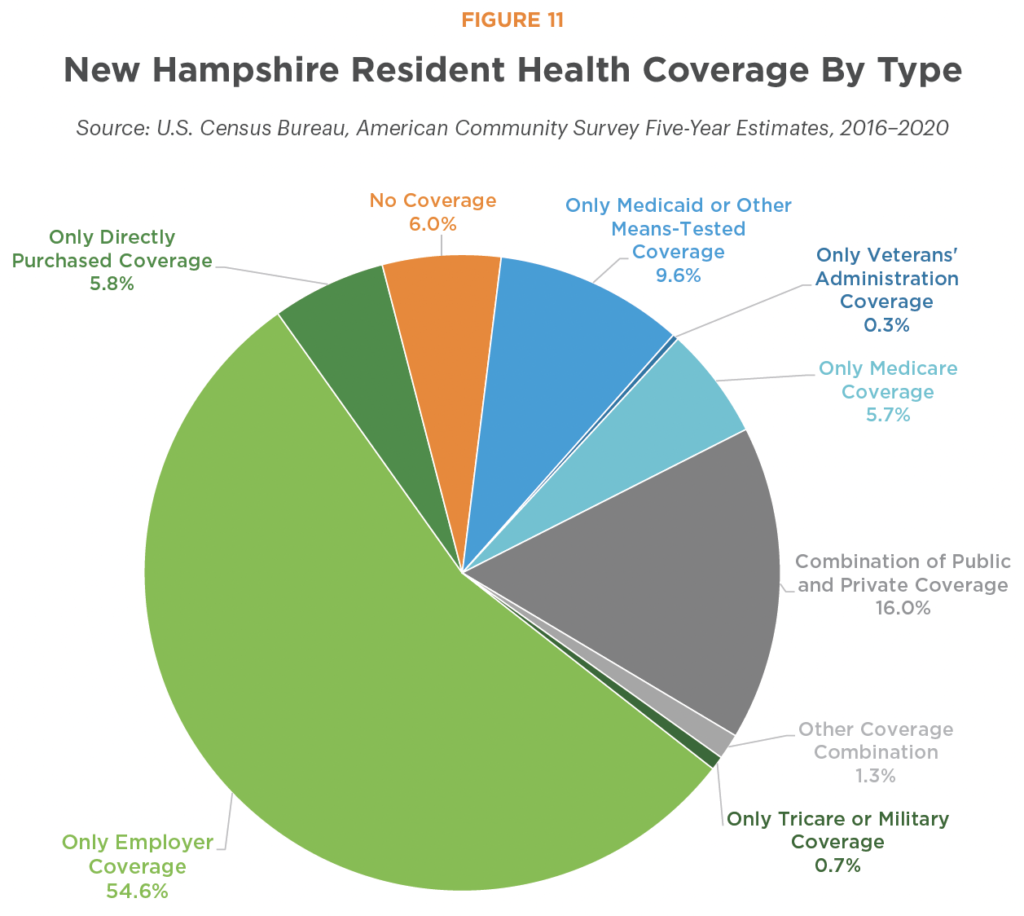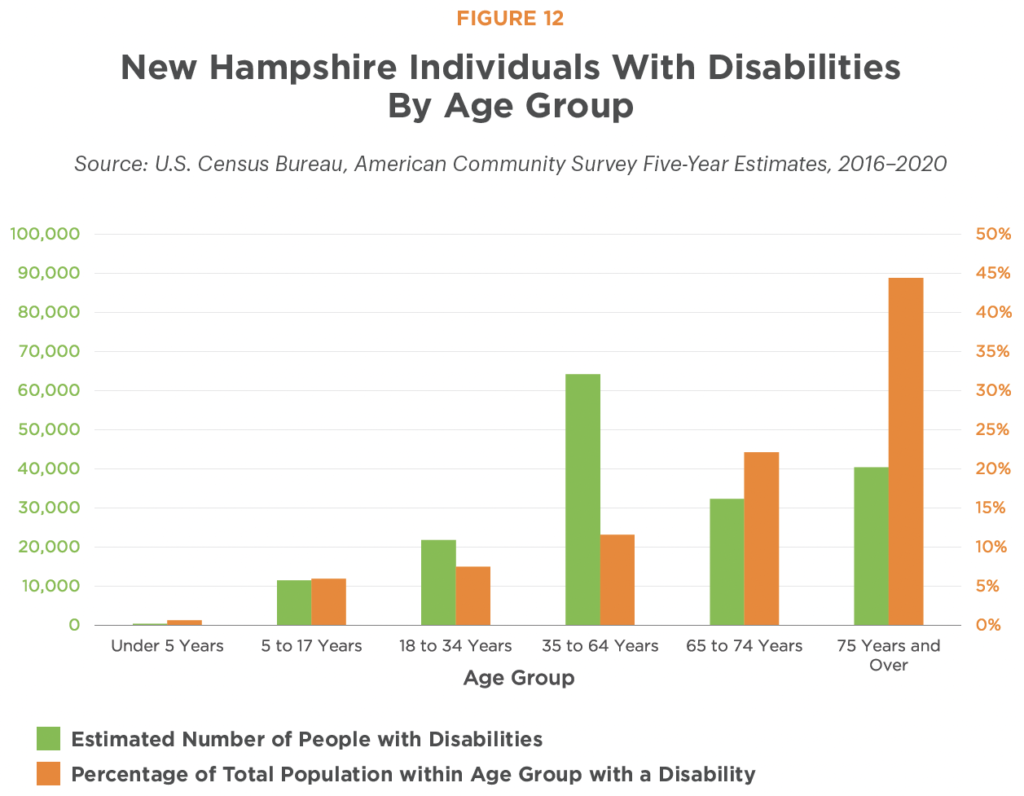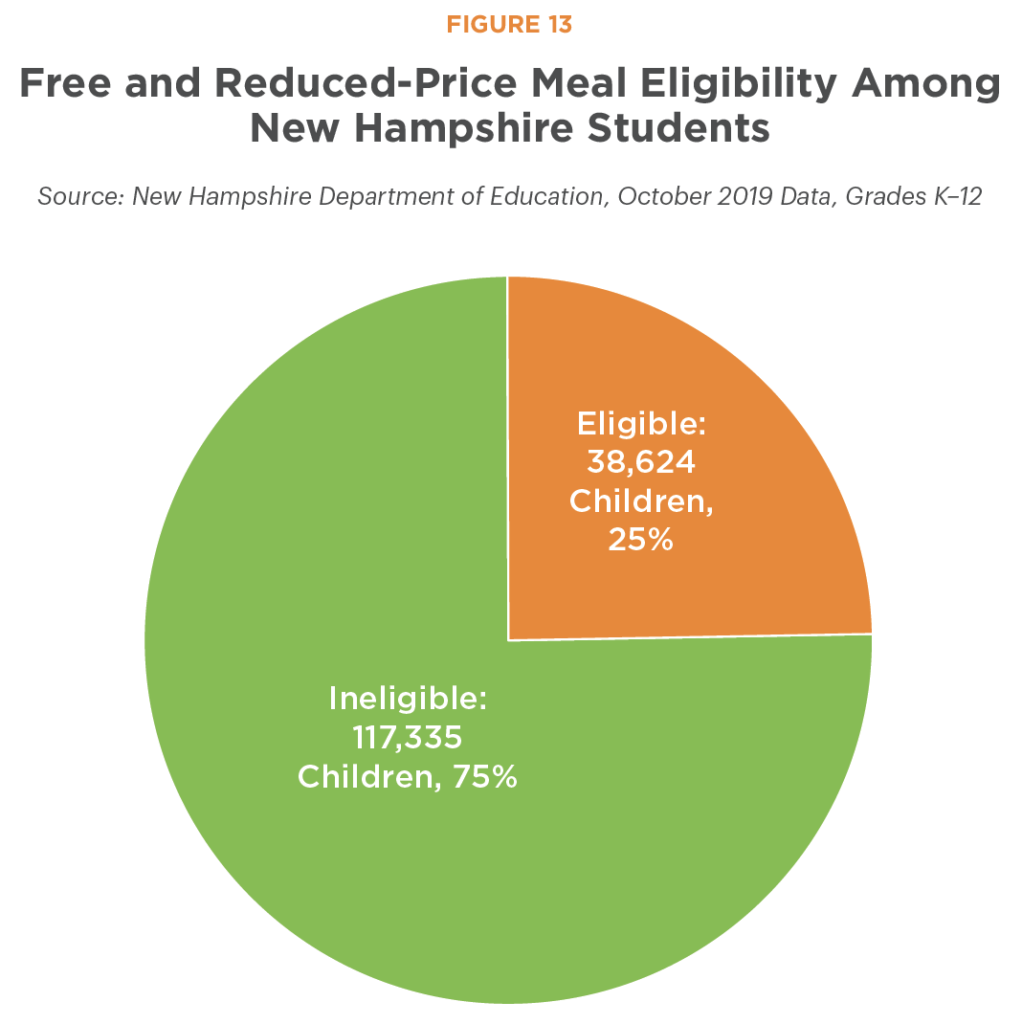This first edition of New Hampshire Policy Points provides an overview of the Granite State and the people who call New Hampshire home. It focuses on some of the issues that are most important to supporting thriving lives and livelihoods for New Hampshire’s residents.
New Hampshire Policy Points is intended to provide an informative and accessible resource to policymakers and the general public alike, highlighting areas of key concern. Touching on some important points but by no means comprehensive, each section within New Hampshire Policy Points includes the most up-to-date information available on each topic area as of October 2022.
The following section, Health, is one of nine sections that frame this resource guide. Other sections cover Population and Demographics, Income and Economic Security, Economy and Jobs, Housing, Education, Broadband Internet, Transportation, and How We Fund Public Services. The facts and figures included within this book provide useful information and references for anyone interested in learning about New Hampshire and contributing to making the Granite State a better place for everyone to call home.
To purchase a print copy or download a free digital PDF of New Hampshire Policy Points, visit nhfpi.org/policypoints
In New Hampshire and across the world, a healthy population contributes to more vibrant economies, lower health care costs, and increased lifespans. Health includes both individual and population-level factors that go far beyond formalized health care. Health is influenced by communities, education, safety, financial resources, and more, all of which contribute to the social determinants of health.
The New Hampshire Department of Health and Human Services defines social determinants of health as “the conditions in which people are born, grow, live, work and age that affect a wide range of health risks, health outcomes, and quality of life.”
For example, income is a key indicator of resources available to individuals and families, which can substantially affect health. Income helps people afford basic needs, such as healthy food and stable housing, that impacts the health of adults and children. Households with lower incomes, particularly below or near poverty levels, are more likely to be food insecure and lack access to nutritious foods. People with low incomes are also more likely to have difficulty affording housing or keeping up with the costs of prescription drugs and medical care. Social determinants of health impact the health of all individuals, and both include and are affected by the systems designed to provide health care to Granite Staters.
Access to Health Coverage and Services
Many New Hampshire residents have relatively good access to health services, but other residents, particularly those in rural areas, may face additional barriers. Access to physicians varies considerably within the state. While there were only 510 people per every one primary care physician in Grafton County in 2019, there were 1,570 people for each one in Strafford County. Between 2000 and 2021, nine out of New Hampshire’s 16 rural hospitals closed their labor and delivery units. An analysis from the Urban Institute indicated that, as a result of unit closures, the median driving time to the nearest labor and delivery units in the Granite State doubled from 2000 to 2018.
Even when health care providers are available nearby, many Granite Staters may not have the financial resources to access these services. About 61 percent of New Hampshire’s population relied solely on private health insurance during 2016 to 2020. These individuals included the approximately 55 percent of all Granite Staters who had coverage solely through their employer, and about 6 percent who relied only on insurance purchased directly, including through the individual insurance marketplace. About 80,000 Granite Staters, or 6 percent of all residents, did not have health coverage of any form. That figure rises to about 11 percent for Granite Staters with incomes below the federal poverty threshold.
The remainder of Granite Staters accessed health services through public insurance or a combination of public and private coverage. Data from 2016–2020 suggest about one in five New Hampshire residents were enrolled in Medicare, with nearly 6 percent of all residents relying on Medicare as their only health coverage. Generally, adults aged 65 years and older are eligible for health coverage under the federal Medicare program. Medicaid, a separate program, is a federal-state partnership designed to help ensure people with low incomes, those who are disabled, individuals who are pregnant, and certain other populations can still access care. In July 2022, approximately 241,000 New Hampshire residents were enrolled in Medicaid, or about 17 percent of the estimated 2021 population. This total included more than 10,000 adults over age 65 years and nearly 100,000 children, including children with severe disabilities or in foster care. Medicaid also provides long-term care coverage to eligible older adults and adults with disabilities. Access to Medicaid has been temporarily but substantially expanded since the beginning of the COVID-19 pandemic, providing a critical support for Granite Staters in need at a time when access to health services has been even more central to well-being.
Older Adults
New Hampshire’s demographics impact the state’s health needs and outcomes. In 2021, the median age of New Hampshire’s population was 43.1 years, which tied with Vermont and West Virginia as the nation’s second oldest, trailing only Maine. An estimated 386,000 adult Granite Staters, about 27.8 percent of the population, were between 55 and 74 years old in 2021.
Older adults are more likely to have some form of disability. In New Hampshire, more than one in five adults age 65 to 74 years had some form of disability during the 2016–2020 period, as did about 44 percent of adults age 75 years and older. For older adults with low incomes and limited assets, Medicaid funds long-term services and supports, both in nursing facilities and in homes or communities. As New Hampshire’s younger adults age over the next two decades, the need for health, transportation, and housing services will increase.
Behavioral Health
As with physical health, the mental health of Granite Staters can have a profound impact on overall well-being. Survey data suggest that, during the first eight months of 2022, about three in ten New Hampshire adults had symptoms of either anxiety disorder, depressive disorder, or both. Comparatively, national data collected in 2019 suggested about one in ten adults had anxiety or depressive disorders prior to the COVID-19 pandemic.
New Hampshire faces challenges providing needed mental health care. Hospital patients often face a considerable waiting period for mental health services to become available, as need has substantially outpaced capacity. In recent years, New Hampshire has made significant investments, including through the establishment of statewide mobile crisis response units for children, to help address these growing needs.
Substance misuse has also had a deep impact on the Granite State in recent years. The number of people in New Hampshire who died in a drug-related death was almost four times that of the number of people who died in a highway motor vehicle accident each year between 2014 and 2020. During this time, drug overdose deaths peaked in 2017 with 490, and remained elevated at 417 confirmed deaths in 2020. The number of people receiving substance use disorder services through Medicaid each month more than doubled between late 2016 and early 2020. That number has continued to rise since the pandemic began, as both health and economic strains exacerbated the stress on individuals.
Food Insecurity
Key federal and state aid programs are designed to help improve access to health care and reduce the risks facing individuals in times of economic hardship. The Supplemental Nutrition Assistance Program (SNAP), known commonly as Food Stamps, provides resources specifically for food. Nationally, food insecurity has been more prevalent among households with children, particularly those with young children, and among households headed by an individual identifying as Black or Hispanic. In New Hampshire, an estimated 30,000 households were food insecure during the 2019 to 2021 period. SNAP disproportionately serves children in New Hampshire; at the end of July 2021, 38.3 percent of the 68,250 Granite Staters enrolled were children, while children comprised only 18.5 percent of New Hampshire’s residents in July 2021. Separately, the Special Supplemental Nutrition Program for Women, Infants, and Children (WIC) served over 12,000 individuals, mostly children and infants, during 2019.
Food assistance is also provided to children from households with low incomes who are attending school. In October 2019, nearly one in four New Hampshire students were eligible for free and reduced-price school meals. Students of color, who account for a growing percentage of all children, are more likely to be eligible for free and reduced-price meals, indicating generally fewer financial resources at home. These assistance programs, targeted at alleviating food insecurity, seek to help improve the well-being of adults and children in both the short- and long-term. Children from food secure households are less likely than their food insecure peers to experience developmental impairments, perform poorly in school, or face adverse health outcomes that lead to a lower quality of life as an adult.
Food assistance programs help enhance food security, boosting the resources available for food and other needs among families with low incomes. This food assistance likely helps improve the health and well-being of individuals and families both immediately and in the future.
• • •
This publication and its conclusions are based on independent research and analysis conducted by NHFPI. Please email us at info@nhfpi.org with any inquiries or when using or citing New Hampshire Policy Points in any forthcoming publications.
© New Hampshire Fiscal Policy Institute, 2022.




